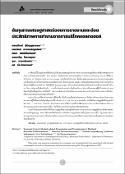บทคัดย่อ
การศึกษานี้มีวัตถุประสงค์เพื่อประเมินต้นทุนทางเศรษฐกิจจากการขาดงานและการสูญเสียประสิทธิภาพขณะทำงานจากการบริโภคแอลกอฮอล์ใน พ.ศ. 2550 โดยทำการสำรวจแบบภาคตัดขวางในประชากรไทย อายุ 15-60 ปี ที่มีงานทำในรอบ 7 วันก่อนการสำรวจ จาก 5,330 ครัวเรือนทั่วประเทศ ซึ่งเป็นกลุ่มตัวอย่างของการสำรวจภาวะเศรษฐกิจและสังคมของครัวเรือนของสำนักงานสถิติแห่งชาติ เดือนกรกฎาคม 2550 เปรียบเทียบผลิตภาพในการทำงานโดยรวมที่ลดลงในผู้ดื่มประเภทต่างๆ โดยใช้สถิติ Kruskal Wallis วิเคราะห์แต่ละปัจจัยและใช้แบบจำลองเส้นตางแบบทั่วไปในการวิเคราะห์หลายปัจจัยพร้อมกัน จากนั้นนำผลต่างของประสิทธิภาพในการทำงานที่ลดลงของผู้ดื่มในแต่ละประเภทเทียบกับผู้ไม่ดื่มคูณด้วยรายได้ต่อปี อัตราการมีส่วนร่วมในกำลังแรงงานและจำนวนประชากรในประเภทการดื่มนั้นๆ เพื่อประเมินต้นทุนทางเศรษฐกิจที่เกิดขึ้น จากการวิเคราะห์ทีละตัวแปรพบว่า ผู้ที่เคยดื่ม ดื่มบ้าง และดื่มอย่างอันตรายมาก มีผลิตภาพในการทำงานโดยรวมลดลงมากกว่าผู้ไม่ดื่มอย่างมีนัยสำคัญทางสถิติ (ร้อยละ 5.6, 1.7 และ 5.7 ตามลำดับ) ก่อให้เกิดความสูญเสียเป็นมูลค่าถึง 26,700-45,464 ล้านบาท ด้วยการคำนวณภายใต้ภาวะคงที่โดยใช้ผลจากการวิเคราะห์ทีละปัจจัยและด้วยการคำนวณตามแบบจำลองความน่าจะเป็น โดยใช้ผลจากการวิเคราะห์หลายปัจจัยพร้อมกัน การบริโภคแอลกอฮอล์ก่อให้เกิดความสูญเสียทางเศรษฐกิจทั้งจากการขาดงานและการสูญเสียประสิทธิภาพขณะทำงานเป็นมูลค่าสูง ผลการศึกษาทำให้สังคมตระหนักถึงความสูญเสียอย่างเป็นรูปธรรมมากขึ้น รัฐบาลควรมีการกำหนดนโยบายและมาตรการที่เหมาะสมในการลดการบริโภคแอลกอฮอล์ในประชากรวัยทำงานเพื่อลดผลกระทบเชิงลบที่เกิดขึ้นต่อไป
บทคัดย่อ
This study was aimed at estimating the economic cost of productivity loss associated with alcohol consumption in term of absenteeism and presenteeism among the Thai population in 2007.
A cross-sectional household survey was carried out among the Thai population aged 15 to 60 years from 4,330 households, who were in paid employment. The impairment rate due to absenteeism and presenteeism for each drinking category was compared using the Kruskal Wallis test for univariate analysis while the generalized linear model (GLM) was used in multivariate analysis. Cost of productivity loss was then calculated as the product of the excess impairment rate, labor force participation rate, income per year, and total number of drinkers in that category.
According to the univariate analysis, the productivity loss in former drinkers, responsible drinkers, and harmful drinkers was significantly higher than in the abstainers at 5.6 percent, 1.7 percent, and 5.7 percent respectively. According to the study, the cost of productivity loss due to alcohol in terms of absenteeism and presenteeism was approximately 26,700 million to 45,464 million baht by using a deterministic approach and univariate analysis, and probalistic approach and multivariate analysis, respectively.
Alcohol consumption is associated with high economic cost in terms of absenteeism and presenteeism in Thailand. This finding can be used to promote the public’s awareness of and draw their attention to the negative impact of alcohol in terms of productivity loss. According to the study, the government and employers should implement more effective policy aimed at reducing alcohol consumption among the working population in order to reduce the economic cost related to absenteeism and presenteeism.


